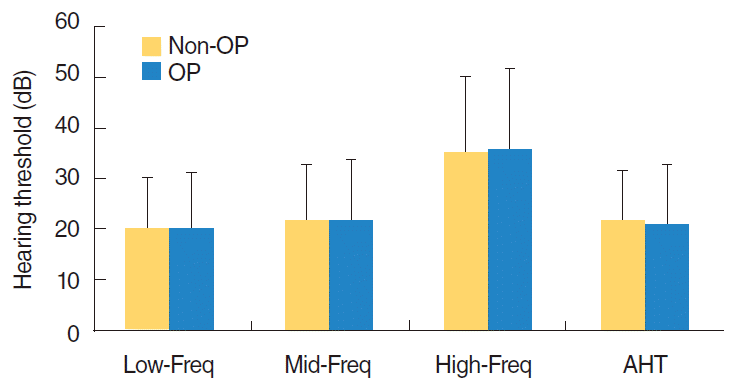1. Swenor BK, Ramulu PY, Willis JR, Friedman D, Lin FR. The prevalence of concurrent hearing and vision impairment in the United States. JAMA Intern Med. 2013; Feb. 173(4):312–3.

2. Looker AC, Melton LJ 3rd, Harris TB, Borrud LG, Shepherd JA. Prevalence and trends in low femur bone density among older US adults: NHANES 2005-2006 compared with NHANES III. J Bone Miner Res. 2010; Jan. 25(1):64–71.

3. Horner KC. Bone and the ear. In : Bronner F, Farach-Carson MC, Roach HI, editors. Bone-metabolic functions and modulators. New York (NY): Springer;2012. p. 251–69.
4. Kim SH, Kang BM, Chae HD, Kim CH. The association between serum estradiol level and hearing sensitivity in postmenopausal women. Obstet Gynecol. 2002; May. 99(5 Pt 1):726–30.

5. Helzner EP, Cauley JA, Pratt SR, Wisniewski SR, Zmuda JM, Talbott EO, et al. Race and sex differences in age-related hearing loss: the Health, Aging and Body Composition Study. J Am Geriatr Soc. 2005; Dec. 53(12):2119–27.

6. Helzner EP, Cauley JA, Pratt SR, Wisniewski SR, Talbott EO, Zmuda JM, et al. Hearing sensitivity and bone mineral density in older adults: the Health, Aging and Body Composition Study. Osteoporos Int. 2005; Dec. 16(12):1675–82.

7. Ozkiris M, Karacavus S, Kapusuz Z, Balbaloglu O, Saydam L. Does bone mineral density have an effect on hearing loss in postmenopausal patients? Ann Otol Rhinol Laryngol. 2013; Oct. 122(10):648–52.

8. Mendy A, Vieira ER, Albatineh AN, Nnadi AK, Lowry D, Gasana J. Low bone mineral density is associated with balance and hearing impairments. Ann Epidemiol. 2014; Jan. 24(1):58–62.

9. Kahveci OK, Demirdal US, Yucedag F, Cerci U. Patients with osteoporosis have higher incidence of sensorineural hearing loss. Clin Otolaryngol. 2014; Jun. 39(3):145–9.

10. Kim JY, Lee SB, Lee CH, Kim HM. Hearing loss in postmenopausal women with low bone mineral density. Auris Nasus Larynx. 2016; Apr. 43(2):155–60.

12. Rehm J, Room R, Monteiro M, Gmel G, Graham K, Rehn N, et al. Alcohol use. In : Ezzati M, Lopez A, Rodgers A, Murray CJ, editors. Comparative quantification of health risks: global and regional burden of disease attributable to selected major risk factors. Geneva: World Health Organization;2004. p. 959–1108.
14. Kang JW, Choi HS, Kim K, Choi JY. Dietary vitamin intake correlates with hearing thresholds in the older population: the Korean National Health and Nutrition Examination Survey. Am J Clin Nutr. 2014; Jun. 99(6):1407–13.

15. Huizing EH, de Groot JA. Densitometry of the cochlear capsule and correlation between bone density loss and bone conduction hearing loss in otosclerosis. Acta Otolaryngol. 1987; May-Jun. 103(5-6):464–8.
16. Clark K, Sowers MR, Wallace RB, Jannausch ML, Lemke J, Anderson CV. Age-related hearing loss and bone mass in a population of rural women aged 60 to 85 years. Ann Epidemiol. 1995; Jan. 5(1):8–14.

17. Monsell EM, Cody DD, Bone HG, Divine GW, Windham JP, Jacobson GP, et al. Hearing loss in Paget’s disease of bone: the relationship between pure-tone thresholds and mineral density of the cochlear capsule. Hear Res. 1995; Mar. 83(1-2):114–20.

18. Monsell EM, Cody DD, Bone HG, Divine GW. Hearing loss as a complication of Paget’s disease of bone. J Bone Miner Res. 1999; Oct. 14 Suppl 2:92–5.

19. Petasnick JP. Tomography of the temporal bone in Paget’s disee. Am J Roentgenol Radium Ther Nucl Med. 1969; Apr. 105(4):838–43.
20. De Groot JA, Huizing EH, Damsma H, Zonneveld FW, van Waes PF. Labyrinthine otosclerosis studied with a new computed tomography technique. Ann Otol Rhinol Laryngol. 1985; May-Jun. 94(3):223–5.
21. Barrenas ML, Lindgren F. The influence of eye colour on susceptibility to TTS in humans. Br J Audiol. 1991; Oct. 25(5):303–7.





 PDF
PDF Citation
Citation Print
Print



 XML Download
XML Download